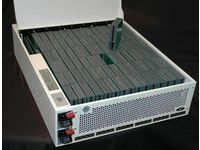SGI Makes Molecule Supercomputer From Intel Atoms
The Intel Atom was designed primarily for low-power demand form factors, mostly being highly mobile internet devices. Sure enough, the vast majority of Intel Atom processors in use today are inside 8.9- and 10-inch netbooks, but what about the Atom inside a supercomputer?
Silicon Graphics (SGI) is showing off a concept supercomputer that could pack as many as 10,000 Intel Atom processors into a single rack. The name SGI gave the concept computer was fittingly cute too, calling it the Molecule.
According to ExtremeTech’s report, the Molecule could offer the computing power and memory bandwidth of more than 750 high-end PCs, while consuming less than half the power and occupying no more than 1.4 percent of the physical space.
The Atom used for SGI’s machine is the recently launched N330, which shares many of the same features as the single-core N230. The main difference, of course, is that the N330 has a second HyperThreaded core, making it doubly effective, but also giving it twice the thermal design power value at 8 W.
Regardless of how power efficient the Atom is, it’s still quite a feat to pack in 10,000 cores into a single rack. SGI said that its Kelvin cooling technology was key to achieving the Molecule.
Image source: Wired.
Get Tom's Hardware's best news and in-depth reviews, straight to your inbox.
-
kschoche Isnt the atom a 32bit processor?Reply
Whats the point if you can do the same thing with slower(clockspeed) ppc chips that are 64bit and probably have better FP units, unless you want to run windows on this... You did say supercomputer. -
pretty neat... can't wait until massively parallel computers are the way of the future... then when one needs more performance... just add a couple hundred processors :DReply
-
ceteras SO, there's 90 modules totaling 10.000 cores. About 1110 cores/module or 555 processors per module. That is impressing.Reply
If you read the Wired source, thy say "While the computer sounds like a powerhouse, it isn't real." No mention about it in the article, why?
This is not a supercomputer, it's just a supercomputer concept.
Get real, please!

